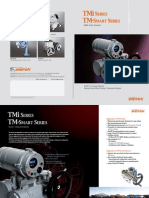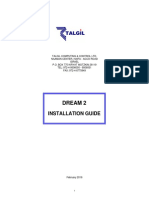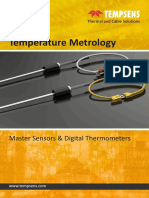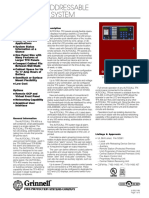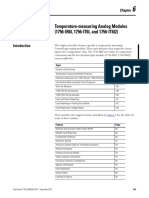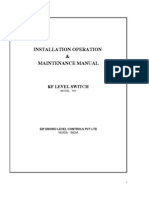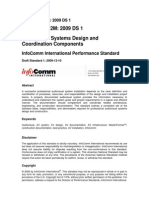LFXGH Basic Setup
LFXGH Basic Setup
Uploaded by
Alvin Garcia PalancaCopyright:
Available Formats
LFXGH Basic Setup
LFXGH Basic Setup
Uploaded by
Alvin Garcia PalancaCopyright
Available Formats
Share this document
Did you find this document useful?
Is this content inappropriate?
Copyright:
Available Formats
LFXGH Basic Setup
LFXGH Basic Setup
Uploaded by
Alvin Garcia PalancaCopyright:
Available Formats
SETUP AND CALIBRATION
Before using the gauge to make measurements, you must: Calibrate it to relate the detection of radiation from the source to the level of the process material. Calibrate the current loop to a reference ammeter or the DCS.
Setting high level
1. 2. 3. 4. 5. 1. 2. 3. 4. 1. 2. 1. 2. 3. 4.
Select Calibration | 2 Point Calibration | Cal High Collect. Click Start. Click Accept. Enter the actual value in engineering units. Click OK. Select Calibration | Linearizer Data Pt | Create Data Point. At the prompt, enter the actual known level of process. Accept or reject the results when they appear. Repeat procedure for all available levels. Select Calibration | Linearizer Data Pt | Recalculate. Click OK to proceed with the linearity calculation. The linearizer table calculates based on the level values. Select Calibration | 2 Point Calibration. Click Calculate Results. Click OK. Click OK. Sensor counts Actual level (engineering units)
Current loop (analog output calibration)
Before a current loop calibration: Connect an ammeter anywhere along the current loop (in series). Make sure there is a 250 800 load on the current loop. If no load or an insufficient load exists on the loop, it may require temporary placement of a resistor. Hook the meter in series with the load resistor. Open Ohmview 2000 and perform the following steps to calibrate the current loop. Setting up 4 mA 1. Select Calibration | Current Loop Cal. 2. Click Execute. 3. Click OK. 4. Read the ammeter; enter the actual milliamp reading. 5. Click OK. 6. Click YES if the ammeter reads 4.00 mA or NO for any other reading. 7. Repeat until the meter reads 4.00 mA. The meter approaches the 4.00 mA successively. 8. Read the ammeter; enter the actual milliamp reading. 9. Click OK. 10. Click OK. Setting up 20 mA 11. Read the ammeter; enter the actual milliamp reading. 12. Click OK. 13. Click YES if the ammeter reads 20.00 mA or NO for any other reading. 14. Repeat until the meter reads 20.00 mA. The meter approaches the 20.00 mA successively. 15. Read the ammeter; enter the actual milliamp reading. 16. Click OK. 17. Click OK.
Collecting linearizer table data
LFXG-H QUICK REFERENCE STARTUP GUIDE
Version 1.0
Calculating the linearizer
SAFETY INSTRUCTIONS
Refer to the Radiation Safety Manual and Reference CD that came with your source holder. Always refer to the safety instructions in this guide and the country specific installation standards. Follow the prevailing safety regulations and accident prevention rules of your company and country.
Calculating the calibration
Data type Cal low level (usually empty) Linearizer data point 0 1 2 3 4 5 6 7 8 9 Cal high level (usually full) Linearizer data point 10
General
Ambient temperature should be between 20 C (4 F) to +60 C (+140 F). There is an option available for lower temperatures. Safety information for EX areas This equipment is suitable for use in the following environment: CSA Class l, Div 1, Groups A, B, C, & D CSA Class I, Div 2, Groups A, B, C, & D CSA Class ll, Div 1 Groups E, F, & G CSA Class II, Div 2, Groups E, F & G ATEX Certificate #II2 G/D EEx d IIC TP6 IP66 20 C to +60C or II2G EEX d IIB+H2 T6 50 C to +60C NEMA Type 4X IP66 Non-hazardous locations
Selecting the linearity
For information on linearity options, see the LFXG-H Installation and Operation Guide. 1. Select Setup | Gauge Setup | Linearizer Type. 2. Click Table | Non-linear or Table - Linear.
Special installation, maintenance, or operating instructions
If it is necessary to open the sensor, the following warning applies: EXPLOSION HAZARD - Do not disconnect equipment unless power has been switched off or the area is known to be non-hazardous. AVERTISSEMENT: - RISQUE D'EXPLOSION - AVANT DE DCONNECTER L'QUIPEMENT, COUPER LE COURANT OU S'ASSURER QUE LEMPLACEMENT EST DSIGN NON DANGEREUX. Caution! Open circuits before removing cover. An explosion-proof seal shall be installed within 450 mm (18) of the enclosure. AVERTISSEMENT: - Ouvrir les circuits avant denlever le couvercle. Un scellement doit tre install moins de 450 mm du botier. Caution! Allow a minimum of 10 minutes before opening the GEN2000 for internal inspection. This allows time for the gauge to de-energize, cool, and full capacitor discharge.
Calibrating the level gauge
See the LFXG-H Installation and Operation Guide for further information on calibration requirements. Standard method (2-point) Simple method 1. Setting the low level and collecting Cal Low data* Skips steps 3 and 4. 2. Setting the high level and collecting Cal High data* 3. Collecting the linearizer table data* 4. Calculating the linearity 5. Calculating the calibration * Perform these data collection steps in any sequence, depending on your ability to empty and fill the vessel.
Ohmart/VEGA Customer Service information
To request field service within the United States and Canada, call 513-272-0131 or e-mail fieldservice@ohmart.com. Customers outside of the United States and Canada should contact their local Ohmart/VEGA representative for parts and service. Copyright 2005 Ohmart/VEGA Corporation, Cincinnati, Ohio. All rights reserved. This document contains proprietary information of Ohmart/VEGA Corporation. It shall not be reproduced in whole or in part, in any form, without the expressed written permission of Ohmart/VEGA Corporation. The material in this document is provided for informational purposes and is subject to change without notice.
Two point process calibration (preferred method)
You must provide high and low process conditions when performing a two point calibration. If using the standard method, it may be helpful to record the sensor counts and levels at each step:
Setting low level
31520-US-051020
1. 2. 3. 4. 5.
Select Calibration | 2 Point Calibration | Cal Low Collect. Click Start. Click Accept. Enter the actual value in engineering units. Click OK.
Unpacking the equipment
Unpack the unit in a clean, dry area. Inspect the shipment for completeness by checking against the packing slip. Inspect the shipment for damage during shipment or storage. If the detector is included as a separate package in the shipment, inspect the assembly for damage. If damaged, file a claim against the carrier and report the damage in detail. Any claim on Ohmart/VEGA for shortages, errors in shipment, or other problems must be made within 30 days of receipt of the shipment. If you need to return the equipment, refer to the LFXG-H Installation and Operation Guide for information concerning returning equipment for repair. After you unpack the equipment, inspect each source holder in the shipment to assure that the source holder is locked.
Mounting Instructions (continued)
WIRING THE EQUIPMENT
Make the connections at the removable terminal strips mounted on the power board. Access the power board by removing the explosion-proof housing cap. There is an internal and external ground screw for connection of the power earth ground wire. Remove the top cover to access the ground screws.
L1
AC o r DC power input
Storing the equipment
Store the source holder in a clean, dry area. Verify that the source holder is locked in the off position. Store the detectors in an area that has a controlled temperature between +10 C and +35 C (+50 F and +95 F) and less than 50% relative humidity.
The detectors active area (where it is possible to make a level measurement) is between 1" (25mm) from the bottom of the GEN2000 housing to the end of the flexible conduit. Mount the detector so this area spans the measurement length. Disconnect switch Install a power line switch no more than one meter from the operator control station. Conduit Conduit runs must be continuous and protected so that moisture condensation does not drip into any of the housings or junction boxes. Use sealant in the conduit, or arrange the runs so that they are below the entries to the housings and use weep holes where permitted. Use a conduit explosion-proof seal in the proximity of the housing when the location is in a hazardous area. Requirements for the actual distance must be in accordance with local code. If you use only one conduit hub, plug the other conduit hub to prevent the entry of dirt and moisture. Note: For European ATEX hazardous area applications, all cable glands or hubs must be EExd rated.
L2 RY NO RY C RY NC Relay: - normally ope n - common - normally closed Not used in HA RT app lica tions Auxiliary in put p ower Common A uxiliary input f requ ency signa l Cu rren t loop outpu t
Mounting Instructions
Your source was sized for optimal performance at the time you ordered your system. Contact us prior to installation if the location of the equipment is different from the original order location. Mounting options: Bracket mountthe L-bracket supports the electronics housing. For this type of mounting, the conduit clamps should be spaced every 18 in. (45cm). Conduit mountthis type of mount consists of an adapter with a 2 in. conduit coupler (part number 240721). It provides an air hose fitting for applications that must cool the gauge. The pole mount requires a nipple and union.
Conduit Mounting Bracket Mounting
Interconne cting term inals GE N200 0 with HART
1/2-13 (12mm) hardware (4 places) 3/4" NPT (2 places)
Checklist for field service commissioning
Mount the source holder and level gauge per the drawings (allow access for future maintenance). � Make all wiring connections using the certified drawings and the instructions in this guide. � If using AC power, ensure that the AC input voltage matches the requirements found on the nameplate of the unit. � Ensure that the AC power to the transmitter is a regulated transient-free power source (UPS type power is best). � If using DC power, verify that the ripple is less than 100mV. � Have process ready for calibration. When possible, it is best to be able to completely fill and empty the vessel at the high and low levels. � Do not remove the source holder lock until the unit is ready for calibration. (Lock can only be removed by a licensed individual.) � Apply power to the gauge 4 hours before starting calibration. Note: The equipment warranty is void if there is any damage to the gauge due to incorrect wiring that has not been checked by an Ohmart/VEGA Field Service Engineer. �
1/4" fitting for optional air hose
2" NPT pipe nipple 2" NPT threaded conduit adapter
Optional pipe mounting shown
Caution! Do Not Apply Power until a thorough check of all the wiring is complete. The AC power source voltage input is 100230 VAC 10% (90250 VAC) at 5060 Hz, at 15 VA (or 25 VA with optional heater) maximum power consumption. AC power must not be shared with transient-producing loads. Use an individual AC lighting circuit. Supply a separate earth ground. The DC power source voltage input is 2060 VDC (<100 mV, 11,000 Hz ripple) at 15 VA maximum power consumption. DC power cable can be part of a single cable 4-wire hookup, or can be separate from output signal cable. Use wire for power per local code. Wire should be suitable for +40 C above surrounding ambient temperature. All field wiring must have insulation suitable for 250 volts or higher. Note: Not all connections are required for operation. The power input terminals are not polarity-sensitive. HART signal may not operate with some isolating barriers or other non-resistive loads.
Output current loop
Output signal is 420 mA into 250800 load. Pin 13 is + and Pin 14 is -. HART communication protocol (BEL202 FSK standard) is available on these connections. The output is isolated to standard ISA 50.1 Type 4 Class U. When using signal (420 mA output) cables that Ohmart/VEGA did not supply, they must meet these specifications: Maximum cable length is 1,000 m (3,280 ft.) All wires should be per local code When using DC power, the signal and power can run on a single cable 4-wire hookup (2 wires for power, 2 for 420 mA).
2" conduit
1 1/4" conduit clamps with 1/4" mounting hole
Follow the site specific installation drawings (this may involve installing the gauge in an inverted position). Mount where process material cannot: � Coat the source holder � Build up between the vessel wall and the detector housing. Mount where the temperature of the process material is relatively stable. Mount the housing as close to the vessel as possible, but outside of any insulation. Note: Protect any insulation from liquids. Verify that there is nothing to absorb radiation between the vessel wall and detector housing. If there are internal obstructions, mount the source holder and gauge on an arc other than a diameter so that the beam of radiation does not cross the obstruction. Avoid source cross-talk when there are multiple adjacent pipes or vessels that have source holders and detectors. The best orientation, in this case, is for the source holders to be on the inside with the radiation beams pointing away from each other.
Auxiliary input frequency signal
RS-485 terminal
Frequency input signal is 0100 kHz , true digital.
Relay
Relay contacts are rated at 6 A at 240 VAC, 6 A at 24 VDC, or 1/4 HP at 120 VAC.
RS-485
The RS-485 connections are labeled on the CPU board. The maximum cable length is 609 meters (2,000 ft.). Use shielded wire per local code. Connect positive terminals together. Connect negative terminals together. Connect ground terminals together.
You might also like
- Electrical Estimator 039 S Manual How To Estimate Electrical Construction Projects Including Everday Labor Installation Rates92% (13)Electrical Estimator 039 S Manual How To Estimate Electrical Construction Projects Including Everday Labor Installation Rates226 pages
- 1zua5492-505 - Gas Detector Relay Model 11 and 12No ratings yet1zua5492-505 - Gas Detector Relay Model 11 and 1216 pages
- Guide To The Installation of PV Systems 2nd Edition100% (1)Guide To The Installation of PV Systems 2nd Edition32 pages
- Engineers Guide - Bebco EPS Pepperl FuchsNo ratings yetEngineers Guide - Bebco EPS Pepperl Fuchs148 pages
- Vacancies... ! Vacancies... !: Location: Tikiri, Rayagada (Odisha)No ratings yetVacancies... ! Vacancies... !: Location: Tikiri, Rayagada (Odisha)4 pages
- Krohne Ultrasonic Flowmeter UFC030 HART Manual PDFNo ratings yetKrohne Ultrasonic Flowmeter UFC030 HART Manual PDF20 pages
- SOR Pressure and Vacuum Detectors CatalogueNo ratings yetSOR Pressure and Vacuum Detectors Catalogue32 pages
- 3300 XL 8mm and 3300 5mm Proximity Transducer System: Installation ManualNo ratings yet3300 XL 8mm and 3300 5mm Proximity Transducer System: Installation Manual36 pages
- DMTA 20090 01EN Rev A NDT SetupBuilder v11 UserNo ratings yetDMTA 20090 01EN Rev A NDT SetupBuilder v11 User204 pages
- TC909A and B, TC910N and R, TC941A: Eclipse™ Series Intelligent ModulesNo ratings yetTC909A and B, TC910N and R, TC941A: Eclipse™ Series Intelligent Modules2 pages
- Manual AlarmScout 910 117 - 4417900 - Rev00No ratings yetManual AlarmScout 910 117 - 4417900 - Rev004 pages
- Clif Mock True Cut: Sampling TechnologiesNo ratings yetClif Mock True Cut: Sampling Technologies4 pages
- Auxiliary Power Supply APS2-6R-E Instruction ManualNo ratings yetAuxiliary Power Supply APS2-6R-E Instruction Manual32 pages
- Hart Transmitter Calibration: Application NoteNo ratings yetHart Transmitter Calibration: Application Note8 pages
- 1718 Ex I/O: Intrinsically Safe Distributed I/O For Zone 1 ApplicationsNo ratings yet1718 Ex I/O: Intrinsically Safe Distributed I/O For Zone 1 Applications3 pages
- Testing Teccor Semiconductor Devices Using Curve Tracers100% (1)Testing Teccor Semiconductor Devices Using Curve Tracers20 pages
- Deburring Work: A Worker Is Deburring A Steel Plate With An Air SunderNo ratings yetDeburring Work: A Worker Is Deburring A Steel Plate With An Air Sunder1 page
- Fire Involving Radioactive Source: Judix/Grieza/RudolfNo ratings yetFire Involving Radioactive Source: Judix/Grieza/Rudolf10 pages
- Emergency Response On The Incident of Missing Radioactive SourceNo ratings yetEmergency Response On The Incident of Missing Radioactive Source9 pages
- Radioactive Source Is Leaking: Michael Alvarez Christian EraNo ratings yetRadioactive Source Is Leaking: Michael Alvarez Christian Era8 pages
- Grinding Work: A Worker Is Grinding Small Parts, Holding It With A PlierNo ratings yetGrinding Work: A Worker Is Grinding Small Parts, Holding It With A Plier1 page
- Transport Accident Involving A Radioactive Source: Hanna Saco Philip CaluyaNo ratings yetTransport Accident Involving A Radioactive Source: Hanna Saco Philip Caluya13 pages
- A Worker Is Drilling A Hole On Work With A Bench Drilling MachineNo ratings yetA Worker Is Drilling A Hole On Work With A Bench Drilling Machine1 page
- On-Site Gas Welding Work: A Service Mechanic Is Flame-Cutting A Steel Plate at An In-Field Repair SiteNo ratings yetOn-Site Gas Welding Work: A Service Mechanic Is Flame-Cutting A Steel Plate at An In-Field Repair Site1 page
- Bolt Tightening: A Worker Is Retightening A Cylinder Pin Stopper BoltNo ratings yetBolt Tightening: A Worker Is Retightening A Cylinder Pin Stopper Bolt1 page
- Engine Oil Replacement: An Operator Is About To Get Off A Hydraulic Excavator, While The Engine Oil Is Being ReplacedNo ratings yetEngine Oil Replacement: An Operator Is About To Get Off A Hydraulic Excavator, While The Engine Oil Is Being Replaced1 page
- Replacement of Cylinder: A Mechanic Is Driving A Connecting Pin in The Arm Cylinder Replacement WorkNo ratings yetReplacement of Cylinder: A Mechanic Is Driving A Connecting Pin in The Arm Cylinder Replacement Work1 page
- Transportation: Dismantled From A Hydraulic Excavator, A Boom Is Going To Be Moved With An Overhead CraneNo ratings yetTransportation: Dismantled From A Hydraulic Excavator, A Boom Is Going To Be Moved With An Overhead Crane1 page
- Product Catalog: Drilling & CompletionsNo ratings yetProduct Catalog: Drilling & Completions33 pages
- UGW9811 Engineering Installation Customer Preparation Guide-20110908-C-1.1100% (1)UGW9811 Engineering Installation Customer Preparation Guide-20110908-C-1.127 pages
- The Future Searchlight Solution: - A Valuable, Versatile Concept For Visibility in Rough Marine EnvironmentsNo ratings yetThe Future Searchlight Solution: - A Valuable, Versatile Concept For Visibility in Rough Marine Environments2 pages
- Part 001 CNT Guide To Control Panel Cable Identification PDFNo ratings yetPart 001 CNT Guide To Control Panel Cable Identification PDF7 pages
- Audiovisual Systems Design and Coordination Components Performance Standard DS1 Public Review100% (1)Audiovisual Systems Design and Coordination Components Performance Standard DS1 Public Review29 pages





















